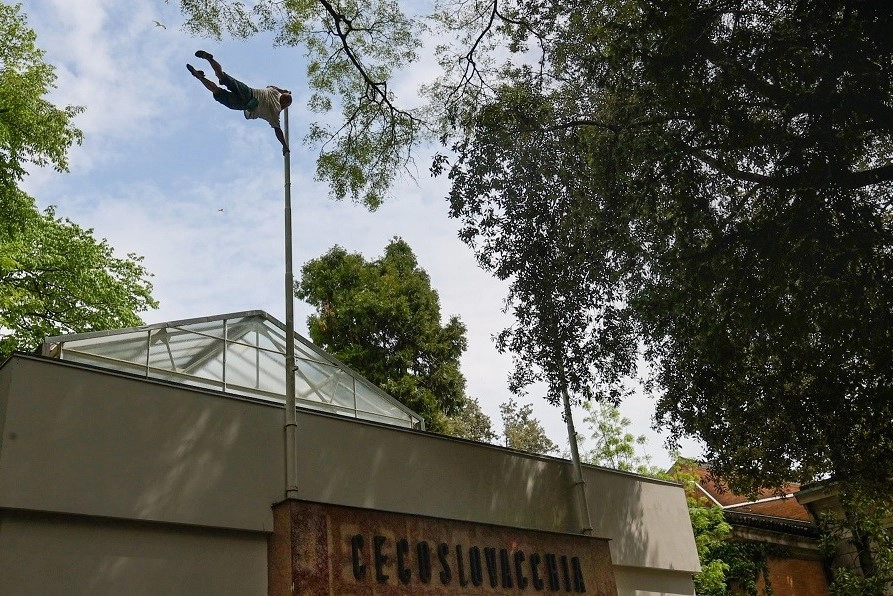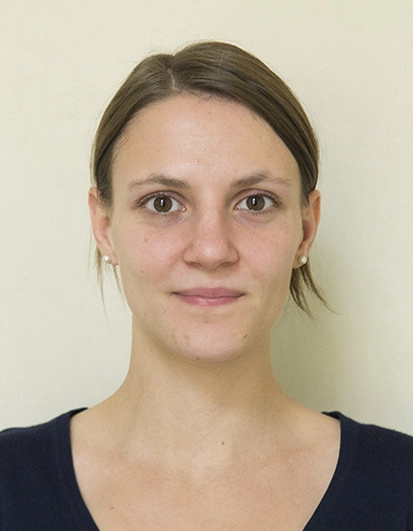The traditional Venice Biennale of contemporary art runs from April till the end of November. The 95th year, curated by the historically first Italian Cecilia Alemani, is taking place without Czech representation.
.jpg)
One of the most significant world exhibitions last took place in 2019. Then, the Czech and Slovak pavilion in the Giardini di Castello park was damaged by a fallen tree. The pavilion that has been long in need of reconstruction has definitively closed to visitors due to this event. Even after a three-year break, prolonged by the pandemic year, the state of the Czech-Slovak pavilion remains unchanged and no other alternative in other venues has been found. Apart from Russia, which has withdrawn from the artistic presentation due to the Ukrainian invasion, the Czech-Slovak pavilion is the only one that remains closed. However, a Czech mark was still left on the Biennale through the works of visual artist Vojtěch Fröhlich.
Breathing exercises and climbing as art
The performance series, titled Pauza (Break), reacts to the absence of the Czech programme as well as the one-year delay in the Biennale events and took place in Venice directly in the space of the pavilion.
The first took place at the Biennale opening on 23rd April which also happens to be Fröhlich’s name day and consisted of several events inside and on the roof of the pavilion where the artist took the place of a missing national flag on the flag mast or entered the building through the damaged skylight and rappelled down into the pavilion using climbing gear.
.jpg)
„Pauza (Break) is a way how to, at least temporarily, breathe life into the Czech-Slovak pavilion during the course of the Biennale through physical human presence. Examining the building as a way of remembering its existence.“
In his work, Fröhlich often faces physically and mentally challenging situations and contends with architecture through climbing or similar outdoor activities. Physical exertion is never the goal, though. He considers the event to be a kind of mental exercise. This is apparent even in Venice where he “explored” the entire structure piece by piece and tried to feel like one with the building.
“I felt that something happened to that building, a tree damaged it and triggered this entire situation. I tried to make the pavilion move so it could start running again. I wanted to give the space a metaphorical acupuncture,” says the author.
Fröhlich repeated the performance on the 14th of October and used the occasion to let a group of visitors look inside by opening the inner door so the space was separated only by bars. This spontaneous event was closed down by Italian security.

Martin Mazanec, whose main focus is animation and video, collaborated on the project as a curator and Slovak illustrator and graphic designer Martin Groch created posters for the performance. In the past, he worked, for example, with Prague City Gallery, VI PER Gallery or the Berlin studio HORST.
The art space from a different perspective
The climbing performance at Venice Biennale is certainly not the first event of this kind Fröhlich has done. He used his climbing experience during the summer semester of 2011 when he started making small interventions into the space of the Prague Academy of Fine Art: he placed down duplicates of certain objects, like clocks (showing a slightly forward time), lights or a reproduction of Eugèn Delacroix. He then used these new “fake” objects as climbing holds, climbing through the entire building of the Academy all the way to the atelier of Tomáš Vaněk, where he studied.
„I wanted to enter into another space within the school that is quite similar to the one that is already here but this one forces us to move differently. (…) This is the idea I build on but I think it opens us to various new ideas. Someone sees it as a critique, someone sees the topic of sports. I always enjoy when things have a clear start and then open up more possibilities and questions, or meanings which have some sort of a direction within the framework of the project..“

A year later Fröhlich climbed again, this time during the opening of the Ostrovy odporu. Mezi první a druhou moderností 1985-2012 (Islands of Resistance. Between the First and Second Modernity 1985-2012) exhibition at the National Gallery’s Trade Fair Palace, mapping the evolution of the Czech art scene for the past two decades. The artist climbed through the entire exhibit and back, naming the project Expedice r.85 (Expedition Year ‘85).
.jpg)
More sweaty art: marathon, slackline and cycling
Even in other Fröhlich’s works where he used sport as a tool of artistic expression we can choose from a wide range of projects.
„I see it as an absolutely natural form of expression,“ he states. „I’ve been doing sports since childhood and I don’t see that much of a difference between running and drawing. It’s just another method, although less typical in the context of art, so people are not used to it. (…) I’m not saying that my physical expression is art, I’m not a dancer. I see art as everything that happens in the framework of the event, starting with installing up to the moment when it’s seen by people.“
In 2011 he was given an opportunity to exhibit at the Prague Academy of Arts, Architecture and Design’s Galerie 207. He transformed the space into a bicycle workshop, featuring bikes with reflective elements that could improve the safety of cyclists.

He completed his studies in 2014 with a project Flow 52-26, presented at the Academy of Fine Arts Graduate Exhibition in the Trade Fair Palace. Fröhlich stretched a 52-metre-long slackline between the walkways of the 5th-floor gallery in the Small Hall at a height of 26 metres above the ground. For a month he then crossed this slackline as a symbol of his departure from the school.
Four years earlier he ran to the exhibition opening at the former exhibition space Benzinka u Slaného all the way from his flat in Letná. The route was exactly 42,195 metres, the same as the length of a marathon and during this run, Fröhlich broke his personal record.
„I wanted to use the run to connect Benzinka at the periphery, to create a link with Prague and this way to show a parallel with the art world (…) I wanted to show the different things art can be about: I practised running the same way I practised drawing, I put the same kind of energy into it I would into painting a picture, even though this is maybe an oversimplified analogy. “
.jpg)
Vojtěch Fröhlich (1985)
Vizuální umělec odmala dělá sport, leze a lyžuje. Ve třinácti vylezl na Mont Blanc. Nejdříve se věnoval fotce na FAMU, pak přešel na AVU, kde v roce 2014 absolvoval. Účastní se řady českých i evropských výstav, v roce 2013 byl vybrán mezi šestici finalistů berlínské Szpilman Award, o dva roky později se stal jedním z finalistů ceny Jindřicha Chalupeckého. Pracujíce s médii fotografie, videa, instalace a živých akcí.





